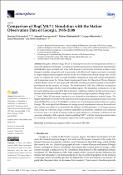Options
Comparison of RegCM4.7.1 Simulation with the Station Observation Data of Georgia, 1985–2008
Journal
Atmosphere
ISSN
2073-4433
Date Issued
2024-03-18
Author(s)
Publisher
MDPI AG
Abstract
The global climate change, driven by natural processes and increasing human activities, is especially significant for Georgia. The region is experiencing increases in temperature, desertification, redistribution of precipitation, and a rise in the frequency and severity of extreme weather events. Georgia’s complex topography and its proximity to the Black and Caspian seas make it essential to employ high-resolution regional climate models to evaluate future climate change risks. In this study, we examine the results of a high-resolution simulation of mean and extreme precipitation and temperature using the Abdus Salam International Centre for Theoretical Physics Regional Climate Model version 4.7.1 for the period 1985–2008, providing an initial evaluation of the model’s performance for the territory of Georgia. The model domain (1524 km; 2388 km) encompasses the entirety of Georgia’s territory and surrounding regions. The simulation, conducted at a 12 km horizontal grid spacing using ERA5 data as boundary conditions, indicates that the least discrepancy between observed and modeled average annual temperatures and precipitation, falling within a −1 to 1 °C and −200 to 200 mm range, respectively, was observed at most stations of eastern Georgia. The largest disparities between the model and observed average annual precipitation totals were noted along the Black Sea coast, in the Kolkheti Lowland, and in some high mountain stations in western Georgia. The most significant differences in average annual temperatures between the model and observations were observed in Ambrolauri, Mt. Sabueti, and Dedoplistskaro. For Georgia territory, such a long run with such a high resolution using ERA5 as boundary conditions was conducted for the first time. Overall, the modeling results are quite satisfactory, providing a solid basis for the successful utilization of the regional climate model RegCM4.7.1 with the selected parameterization for modeling monthly mean and extreme temperatures and precipitation in Georgia.
Subjects
File(s)
Loading...
Name
RegCM4.7.1 სიმულაციის შედარება სადგურებთან საქართველოს დაკვირვების მონაცემებით 1985–2008 წწ.pdf
Size
5.57 MB
Format
Adobe PDF
Checksum
(MD5):92fed906b5084da2520dc81a5c7f31c3